
Argyra is a genus of flies in the family Dolichopodidae. The name "Argyra" comes from the Greek word for "silver".

Eusthenopteron is a genus of prehistoric sarcopterygian which has attained an iconic status from its close relationships to tetrapods. The name derives from two Greek stems—eustheno- "strength" and -pteron "wing" and thus "strongly developed fins". Early depictions of this animal show it emerging onto land; however, paleontologists now widely agree that it was a strictly aquatic animal. The genus Eusthenopteron is known from several species that lived during the Late Devonian period, about 385 million years ago. Eusthenopteron was first described by J. F. Whiteaves in 1881, as part of a large collection of fishes from Miguasha, Quebec. Some 2,000 Eusthenopteron specimens have been collected from Miguasha, one of which was the object of intensely detailed study and several papers from the 1940s to the 1990s by paleoichthyologist Erik Jarvik.
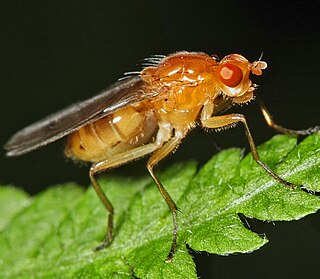
The Dryomyzidae are a small family of flies ranging from 4–18 mm long, with prominent bristles, and yellow to brown or rust-yellow coloring. The wings are very large. The subcosta is complete and well separated from vein 1. Larvae feed on decaying organic matter - carrion, dung, and fungi. The prelambrum protrudes from the oral cavity. Vibrissae are absent and the postvertical bristles are divergent.

The Opetiidae or flat-footed flies are members of a family of flies. The family contains only five extant species in two genera, Opetia, and Puyehuemyia. the remaining taxa are known only from fossils.
Trematochampsa is a dubious extinct genus of crocodyliform from the Late Cretaceous In Beceten Formation of Niger.
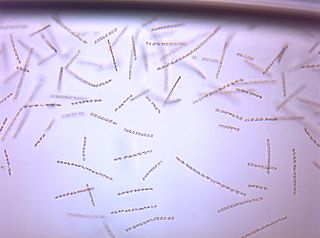
Chaetoceros is probably the largest genus of marine planktonic diatoms with approximately 400 species described, although many of these descriptions are no longer valid. It is often very difficult to distinguish between different Chaetoceros species. Several attempts have been made to restructure this large genus into subgenera and this work is still in progress. However, most of the effort to describe species has been focused in boreal areas, and the genus is cosmopolitan, so there are probably many tropical species still undescribed. Some species are known from the fossil record, from the Quaternary of Sweden. It is the type genus of its family.

Peridinium is a genus of motile, marine and freshwater dinoflagellates. Their morphology is considered typical of the armoured dinoflagellates, and their form is commonly used in diagrams of a dinoflagellate's structure. Peridinium can range from 30 to 70 μm in diameter, and has very thick thecal plates.

Anepsiomyia is a genus of flies in the family Dolichopodidae. It contains only one extant species from Europe, A. flaviventris, as well as two fossil species from the Eocene of Russia and Belarus.
Palaeomedeterus is an extinct genus of flies in the family Dolichopodidae, known from Baltic amber from the Eocene. The genus was first proposed by Fernand Meunier in 1894 with no included species or description, though illustrations were provided for six different unnamed species.
Wheelerenomyia is an extinct genus of flies in the family Dolichopodidae, known from the Eocene of the Baltic region. The genus was first described in 1907 by Fernand Meunier, who named it after William Morton Wheeler.
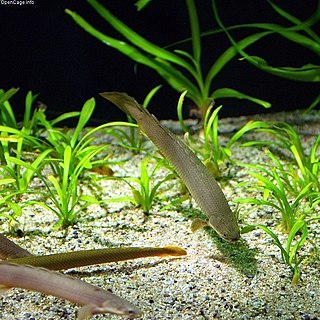
Cladistia is a clade of bony fishes that currently consists of few anguilliform (eel-shaped) remnants of an ancient diversity. Their major synapomorphies are a dorsal fin with independent rays, and a posteriorly elongated parasphenoid.
Bolbomyia is a genus of snipe flies, and the sole genus in the family Bolbomyiidae; until 2010, it was placed in the family Rhagionidae. They are a small 2 to 3.5 mm, brown or black in color, with lightly infuscate (darkened) wings. They are restricted to the north temperate region of North America and Russian Far East (Kamchatka).
Distocyclus is a genus of South American glass knifefishes, with one species in the Amazon basin and another in rivers in French Guiana.
Paleoplatyura is a genus of predatory fungus gnats in the family Keroplatidae. There are about seven described species in Paleoplatyura.
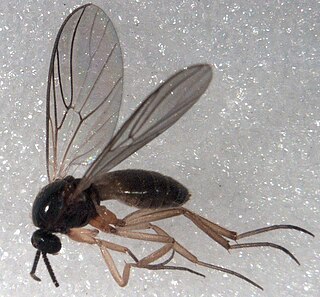
Mycetobia is a genus of wood gnats in the family Anisopodidae. There are more than 20 described species in Mycetobia.
Rymosia is a genus of flies belonging to the family Mycetophilidae.
Anaclileia is a genus of flies belonging to the family Mycetophilidae.
Palaeodocosia is a genus of flies belonging to the family Mycetophilidae.
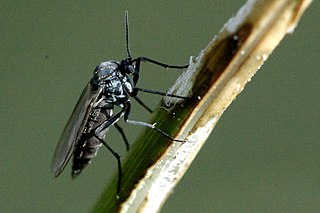
Tetragoneura is a genus of flies belonging to the family Mycetophilidae.
Oedalea is a genus of flies belonging to the family Hybotidae.









